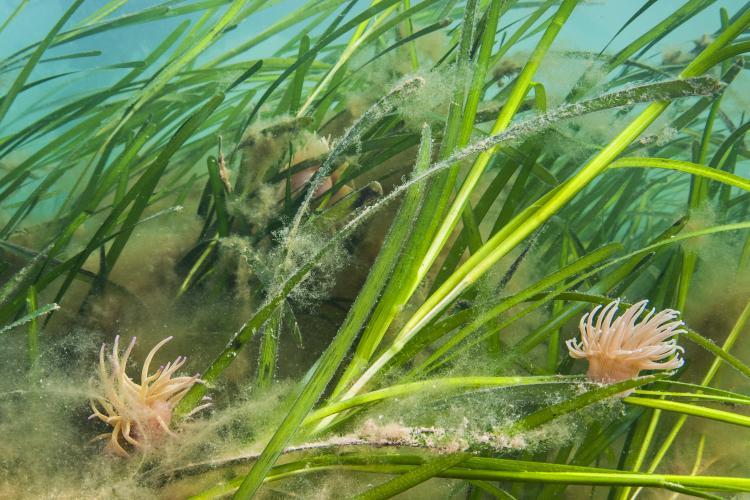Seagrass Genomics
Seagrasses are unique flowering plants, adapted to a fully submerged existence in the highly saline environment of the ocean, where they must root in reducing sediments, endure chronic light limitation and withstand considerable hydrodynamic forces. In spite of these obstacles, the 80 or so species are among the most widely distributed flowering plants with recently measured estimates of coverage ranging from 600,000 km² to a modeled value of 1.6 million km². Seagrasses fulfill many critical ecosystem functions and services including carbon sequestration, nutrient cycling, bacterial suppression and coastal erosion protection. Along with mangroves, salt marshes and coral reefs, seagrass meadows are among the most biologically productive ecosystems on Earth. They act as breeding and nursery grounds for a huge variety of organisms including juvenile and adult fish, epiphytic and free-living algae, molluscs, bristle worms, nematodes and other invertebrates such as scallops, crabs and shrimp. Their importance for marine megafauna such as sea turtles, dugongs and manatees is unrivaled, and their disappearance is an important driver of the decline of these marine animals. Seagrasses also rank among the most efficient natural carbon sinks on Earth, sequestering CO₂ through photosynthesis and storing organic carbon in sediments for millennia. While occupying only 0.1% of the ocean surface, seagrasses have been estimated to bury 27–44 Tg of organic carbon per year globally, accounting for 10–18% of the total carbon burial in the oceans and being up to 40 times more efficient at capturing organic carbon than land-forest soils.
Our first seagrass genome project focused on Zostera marina, where we uncovered several unique gene family losses, as well as metabolic pathway losses and gains, that collectively underlie novel structural and physiological traits, along with evidence for ancient polyploidy. More recently, we expanded on this work and presented new chromosome-scale, high-quality reference genomes to understand the specific morphological and physiological adaptations that have enabled their worldwide distribution, except for Antarctica. These include Posidonia oceanica (L.) Delile (Posidoniaceae), Cymodocea nodosa (Ucria) Ascherson (Cymodoceaceae) and Thalassia testudinum K. D. Koenig (Hydrocharitaceae) to chromosome-level assemblies, and a closely related freshwater-submerged alismatid, Potamogeton acutifolius Link (Potamogetonaceae), to draft level. Representative seagrass species within each family were chosen on the basis of ecological importance, susceptibility to anthropogenic pressure and availability of an extensive ecological literature. Briefly, P. oceanica is the iconic Mediterranean seagrass and the largest in terms of plant size and physical biomass. It is a climax species characterized by extreme longevity and carbon storage capacity. Thalassia testudinum (turtle grass) is a climax tropical species unique to the greater Caribbean region, with a single sister species endemic to the Indo-Pacific. Cymodocea nodosa is restricted mainly to the Mediterranean, Black and Caspian Seas, with an Atlantic extension along the Canary Island archipelago and along the subtropical Atlantic coast of Africa. It is the only temperate species of an otherwise disjunct tropical genus from the Indo-Pacific. The curly pondweed P. acutifolius belongs to the sister family of Zosteraceae and was chosen as its closest submerged freshwater sister taxon. We also updated the genome of Z. marina L., which is found throughout the Northern Hemisphere and is arguably the most widespread seagrass species on the planet. To distinguish between adaptations to an aquatic lifestyle and those unique to the ocean environment, our comparative analysis also included the genomes of two recently sequenced emergent freshwater alismatids (which are rooted in underwater substrate but have leaves and stems extending out of the water), along with the genomes of two distantly related salt-water-tolerant mangrove species.
To better understand the extremely rare transition from a freshwater environment to a submerged saline environment, we compared gene family and pathway evolution across species, considering gene loss as well as gene birth through small- and large-scale gene duplication events, and investigated their effect on plant body structure (cell walls, stomata and hypolignification) and their relationship to physiological adaptations (hypoxia, plant defence, secondary metabolites, light perception, carbon acquisition, heat shock factors and especially salt tolerance mechanisms).
We found that the transition from submerged-freshwater to submerged-marine environments mainly involved fine-tuning of multiple processes (such as osmoregulation, salinity, light capture, carbon acquisition and temperature) that all had to happen in parallel, probably explaining why adaptation to a marine lifestyle has been exceedingly rare. Major gene losses related to stomata, volatiles, defence and lignification are probably a consequence of the return to the sea rather than the cause of it.
For more information on this project you can read the news article.
Papers:
- Olsen, J. L., Rouzé, P., Verhelst, B., Lin, Y. C., Bayer, T., Collen, J., ... & Van de Peer, Y. (2016). The genome of the seagrass Zostera marina reveals angiosperm adaptation to the sea. Nature, 530(7590), 331-335.
- Ma, X., Olsen, J. L., Reusch, T. B., Procaccini, G., Kudrna, D., Williams, M., ... & Van de Peer, Y. (2021). Improved chromosome-level genome assembly and annotation of the seagrass, Zostera marina (eelgrass). F1000Research, 10.
- Ma, X., Vanneste, S., Chang, J., Ambrosino, L., Barry, K., Bayer, T., ... & Van de Peer, Y. (2024). Seagrass genomes reveal ancient polyploidy and adaptations to the marine environment. Nature plants, 10(2), 240-255.
